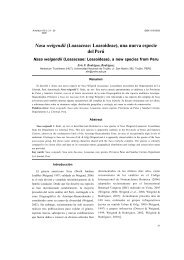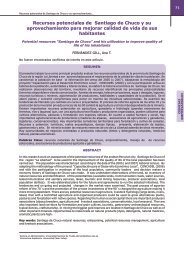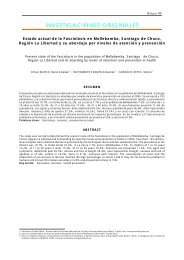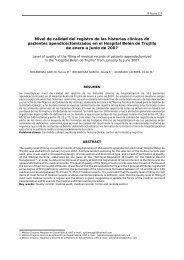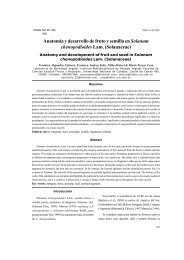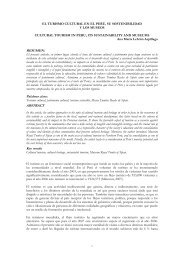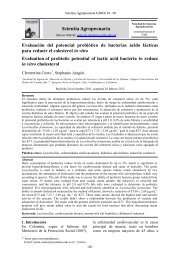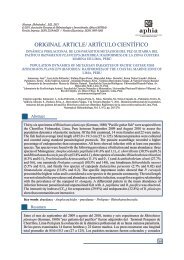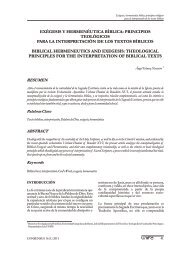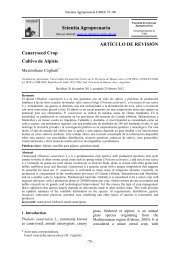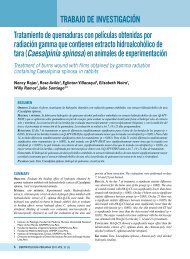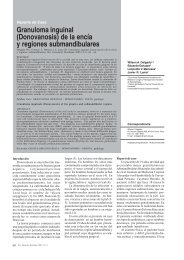temas libres presentados en el xxvi congreso ... - Revista Peruana
temas libres presentados en el xxvi congreso ... - Revista Peruana
temas libres presentados en el xxvi congreso ... - Revista Peruana
You also want an ePaper? Increase the reach of your titles
YUMPU automatically turns print PDFs into web optimized ePapers that Google loves.
62(HbA1C = 8.2%, glucose = 263 mg / dl) , Insulinstarting mix for one year without achieving glycemiccontrol. At 5 years, 6 months started using insulinlispro and a month later added metformin 250 mg/ day for insulin resistance. At 10 years 10 monthsbeginning of puberty is found with bilateral testicularvolume 5 cc Vp1. Are performed liver function testsin normal range. At 12 years shows persist<strong>en</strong>turinary calcium in the urine of 24 hrs (22.9 mg) asstarting hydrochlorothiazide + amilorideComm<strong>en</strong>tThis is a rare syndrome characterized by highinsulin resistance, intermediate betwe<strong>en</strong> th<strong>el</strong>eprechaun and the syndrome type A.Among the clinical findings are d<strong>en</strong>tal dysplasia,and other dysmorphic pineal hyperplasia. It wasfirst described in 1953 by M<strong>en</strong>d<strong>en</strong>hall in a childwith severe insulin resistance in the autopsyshowed pineal hyperplasia. These pati<strong>en</strong>ts areusually pres<strong>en</strong>t in other syndromes associatedwith insulin resistance and acanthosis nigricans,abundant growth of hair and nails, and hyperplasiapseudopuberty phallic (*)The prognosis of childr<strong>en</strong> with this syndrome isvery poor, although better than in the case of theLeprechaun. This diabetes is extrem<strong>el</strong>y difficult tocontrol takes place in childhood and oft<strong>en</strong> att<strong>en</strong>dacidoacetosis severe complications such asmicrovascular injury.Have be<strong>en</strong> id<strong>en</strong>tified in several cases mutationsin the insulin receptor g<strong>en</strong>e involving both all<strong>el</strong>es.There is no known etiology of pineal hyperplasia.Edad de diagnóstico clínico d<strong>el</strong> hipotiroideocongénito: veinte años despuésFal<strong>en</strong> J, D<strong>el</strong> Águila C 1 , Tovar N, Hernández A 2 ,Torres F y Susaya R 3RESUMEN:Objetivo: El hipotiroidismo congénito es unade las principales causas de retardo m<strong>en</strong>talprev<strong>en</strong>ibles. El propósito d<strong>el</strong> pres<strong>en</strong>te trabajo es<strong>el</strong> de determinar la edad actual de diagnóstico d<strong>el</strong>hipotiroideo congénito mediante criterios clínicos.Materiales y Métodos: Se trata de un estudio detipo descriptivo, longitudinal y retrospectivo. Serevisaron 247 historias clínicas, de las cuales sólo37 reunieron los criterios de inclusión. Los datosfueron consignados <strong>en</strong> una ficha confeccionadapara este propósito; para la evaluación clínicase siguieron los criterios descritos por BlancoLopez y cols., los datos de antropometría fueronanalizados con <strong>el</strong> programa EPI-INFO 2002. Elanálisis de los datos recogidos fue realizado con<strong>el</strong> programa estadístico Statistical Package for theSocial Sci<strong>en</strong>ce (SPSS Inc. Chicago III).Resultados: Se halló una mayor incid<strong>en</strong>cia <strong>en</strong> <strong>el</strong>sexo fem<strong>en</strong>ino (78%) que <strong>en</strong> <strong>el</strong> sexo masculino(22%), con una r<strong>el</strong>ación F/M de 3.62/1. La edadpromedio al mom<strong>en</strong>to d<strong>el</strong> diagnóstico fue de 5.93± 5.28 meses para <strong>el</strong> total de la muestra. Lasmanifestaciones clínicas mayores al mom<strong>en</strong>tod<strong>el</strong> diagnóstico fueron: facies abotagada (73%),pi<strong>el</strong> seca (70.3%), fontan<strong>el</strong>as amplias (70.3%),estreñimi<strong>en</strong>to (64.9%), hipotonía (64.9%) eictericia (64.9%). Así mismo, se evid<strong>en</strong>ció unmarcado retardo d<strong>el</strong> crecimi<strong>en</strong>to. Posterior aldiagnóstico y con la administración de L-tiroxina,<strong>el</strong> patrón de crecimi<strong>en</strong>to muestra <strong>en</strong>carrilami<strong>en</strong>tod<strong>el</strong> crecimi<strong>en</strong>to <strong>en</strong> lo que debería ser su patrónde crecimi<strong>en</strong>to y mejorami<strong>en</strong>to d<strong>el</strong> peso; <strong>el</strong> P/Tpres<strong>en</strong>ta un z-score > +1.Conclusiones: La edad promedio de diagnósticod<strong>el</strong> hipotiroideo congénito fue de 5.93 ± 5.28meses, que contrasta notablem<strong>en</strong>te con la edadde diagnóstico <strong>en</strong>contrada por D<strong>el</strong> Águila et al. quefue de 17,4 meses. Como <strong>en</strong> <strong>el</strong> estudio anteriorse <strong>en</strong>contró una mayor frecu<strong>en</strong>cia <strong>en</strong> <strong>el</strong> sexofem<strong>en</strong>ino. El <strong>en</strong>tr<strong>en</strong>ami<strong>en</strong>to de los resid<strong>en</strong>tesde Pediatría <strong>en</strong> la detección clínica precoz deesta <strong>en</strong>tidad ha permitido disminuir la edad dediagnóstico de esta <strong>en</strong>tidad.Age of clinical diagnosis of cong<strong>en</strong>italhypothyroidism: tw<strong>en</strong>ty years laterABSTRACT:Objective: Cong<strong>en</strong>ital hypothyroidism is one of th<strong>el</strong>eading causes of prev<strong>en</strong>table m<strong>en</strong>tal retardation.The purpose of this study is to determine thecurr<strong>en</strong>t age of diagnosis of cong<strong>en</strong>ital hypothyroidby clinical criteria.Materials and Methods: This study was adescriptive, longitudinal and retrospective. 247medical records were reviewed, of which only 37met the inclusion criteria. Data were <strong>en</strong>tered in aform tailored for this purpose, for clinical evaluationfollowed the criteria described by Blanco Lopez et



